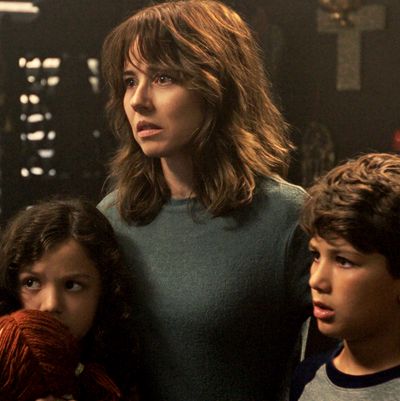
The Conjuring may have been a masterpiece of modern horror in 2013, but the titles that have followed — the lucrative sequels, spinoffs, and sequels to spinoffs — have offered diminishing artistic returns with bland stories and cheaper frights. Seen in that light, The Curse of La Llorona, which expands this so-called cinematic universe with the introduction of a ghost from Mexican folklore, is a welcome new development. Or to put it another way: Hooray, it’s scary!
La Llorona, or “the crying woman,” is the name given to the ghost of a mother who, in 1673, drowned her sons as a way of getting back at her philandering husband. Weeping over her kids, she now returns as a terrifying, white-veiled apparition and tries to take other people’s children. Our heroine, recently widowed social worker and single mom Anna Tate-Garcia (Linda Cardellini), doesn’t take the myth seriously when one of her beleaguered cases tells her about it. Anna is convinced that the burn marks on the woman’s children and the traumatized looks on their faces come from a far more mundane but real monster: an abusive parent. But soon enough, Anna’s own kids are being terrorized by La Llorona, and our heroine’s colleagues are investigating her for child endangerment, in the kind of reversal that has become de rigueur for disbelieving genre protagonists.
Part of the measure of any traditional horror film has to be the clever new visual reflections and misdirections it introduces, and La Llorona is filled with nifty scares, as the ghost is seen in darkened car windows and transparent umbrellas and convex security mirrors. Not unlike the original Conjuring, it takes old-fashioned ghost-story and haunted-house devices — creaking doors and sleepwalking kids and conveniently timed blackouts — and revitalizes them. One set piece inside a parked car, whose windows keep rolling down and whose doors refuse to close properly, is enough to make you grab your armrest so hard you might never want to let it go. There’s a strain of dark poetry to the monster’s appearances, too: La Llorona often materializes out of billowing curtains and in shimmering puddles of water, as if Wes Craven had decided to hijack an Andrei Tarkovsky film.
So it’s a visually splendid and frightening effort, and for some that will be enough. But the film makes a curiously shallow impact. Derivativeness in horror is rarely a crime, since templates and setups are recycled ad infinitum and each subgenre seems to have its own set of highly specific demands. But even by those standards, the story of The Curse of La Llorona feels a little too familiar, hitting a few too many tired beats with its expository priests and brooding exorcist-style shamans. (There is even some dialogue that feels directly recycled from the original Conjuring.) Anna has all the ingredients of a potentially moving character and Cardellini is a fine actress, but she is quickly reduced primarily to creeping, running, and jumping. We wish the film would give her more to do emotionally than just be scared or angry.
La Llorona herself has a sad enough backstory that, along with Anna and her family’s melancholy predicament, this whole tale should hit us harder. All those effectively mounted scares shouldn’t just make us jump but should linger and gnaw at our minds. Maybe the lightness is intentional, though. Ghost stories are built on the idea that some agonies are so devastating even heaven and hell demand they be resolved before opening the gates to the afterlife. The modern horror blockbuster has to take that unspeakable concept and turn it into less heavy, lowest-common-denominator entertainment, which often feels like a letdown. The Curse of La Llorona ultimately doesn’t transcend those origins, but it does split the difference: It is a terrifically scary movie that I wish were more haunting.


